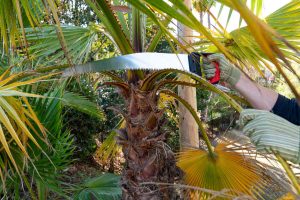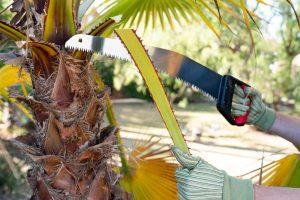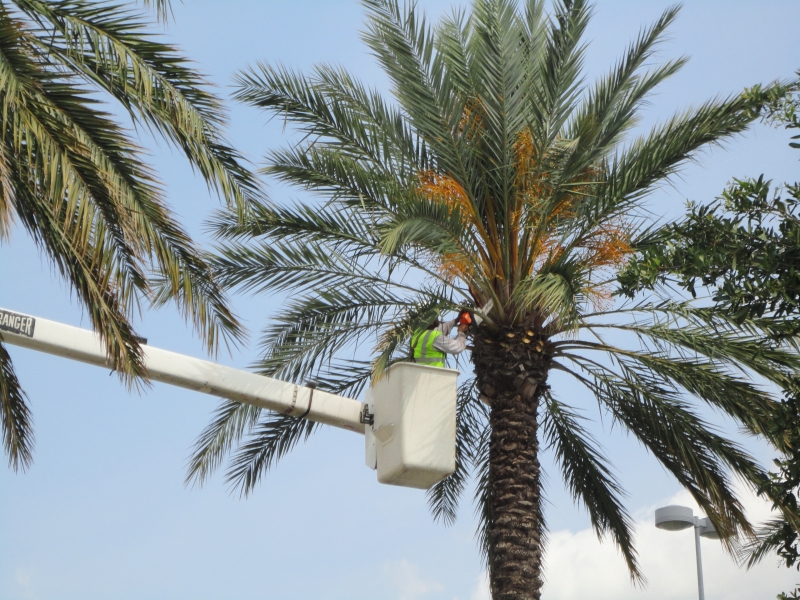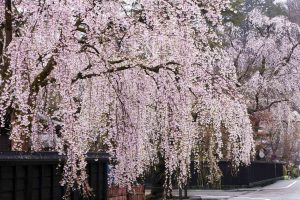How to trim a palm tree?
Beginning the adventure of how to trim a palm tree requires a thorough understanding of the complicated anatomy of these beautiful natural beauties. Palms, with their unbranched stems and huge, fan-shaped or feather-like leaves, have a distinct growth pattern when compared to other trees. The central bud, sometimes known as the “crown” or “heart,” is necessary for growth and should be protected during cutting. Fronds, or big leaves, serve an important function in photosynthesis and should be properly pruned to ensure overall health. A fibrous root structure below the surface supports stability and nutrient uptake. Arborists at Heights emphasize the importance of identifying these important characteristics, allowing enthusiasts to make informed trimming decisions and cultivating a thriving and visually pleasing palm landscape.
Understanding Palm Tree Anatomy
Beginning the process of palm tree pruning requires a thorough understanding of the complicated anatomy of these magnificent botanical miracles. Palms, with their unbranched stems and huge, fan-shaped or feather-like leaves, have a distinct growth pattern in comparison to other trees. The middle bud, sometimes known as the “crown” or “heart,” is essential for growth and should be preserved during trimming. Fronds, or big leaves, are essential for photosynthesis and should be pruned selectively to ensure general health. A fibrous root structure under the surface guarantees nutrition uptake and stability. Arborists at Heights emphasize the importance of knowing these crucial qualities, allowing fans to make informed trimming decisions that promote a thriving and visually pleasing palm landscape.
The Arborist Heights Advantage: Why Choose Us?
Arborist Heights is the leading choice for palm tree care, providing a unique combination of skill, dependability, and a passion for arboriculture. Here’s why picking us is a quality-driven decision.

- Trained Arborists: Our staff includes trained arborists with significant expertise of palm tree maintenance, ensuring the highest industry standards.
- Customized Solutions: We recognize that every palm is unique. Arborist Heights offers bespoke solutions tailored to your plants’ specific needs.
- Safety First: Our top priority is safety. Arborist Heights follows strict safety protocols, ensuring a risk-free and effective service.
- Comprehensive Services: Arborist Heights provides a range of services, including routine pruning and disease care, to help your palms thrive in all aspects.
Arborist Heights offers unrivalled knowledge and a dedication to promoting the health and beauty of your palm trees.
The Art of Timing: When to Trim Your Palms
Mastering the art of palm tree pruning entails more than just understanding anatomy; timing is critical to maintaining the health and vitality of these famous trees. Trimming palms is best done during the growing season, which is often late spring or early summer. This time helps the tree to recuperate quickly, encouraging new growth. Trimming should be avoided during the dormant season since it can impede the tree’s capacity to recover. At Arborist Heights, we prioritize cutting schedules that correspond to the natural cycle of palm development. By synchronizing with the tree’s biological clock, devotees can cultivate blooming palms that demonstrate precise care and Arborist Heights’ experience in the delicate art of timekeeping.
Related Posts:
How to trim a palm tree?
Tools of the Trade: Essential Equipment for Effective Trimming
Pruning Shears: Essential for precise cuts on smaller fronds.
Loppers: Ideal for larger fronds and branches.
Pruning Saw: Enables efficient cutting of thicker branches.
Climbing Gear: Ensures safe access to taller palms.
Safety Equipment: Includes gloves, goggles, and a helmet for protection.
Pole Saw: Useful for reaching higher fronds without climbing.
Rope and Harness: Ensures safety when climbing tall palms.
Chainsaw: For larger, tougher branches.
Wheelbarrow: Facilitates the removal of cut fronds.
Trash Bags: Helps in the organized disposal of trimmings.
Step-by-Step Guide to Palm Trimming
Trimming palm trees is an art that, when done correctly, protects the health and beauty of these iconic plants. Follow this complete guide from Arborist Heights for a smooth palm trimming experience:

Begin by evaluating the general health of the palm. Recognize dead or diseased fronds, blooms, and fruit clusters.
Equip yourself with the required instruments, such as pruning shears, a pruning saw, gloves, safety glasses, and a ladder if needed.
Trim the lowest fronds first, then work your way up. Remove any brown or yellowing fronds, as they sap vitality from the tree.
Cut away any dead or drooping flowers to improve the aesthetics and avoid any risks.
If your palm produces fruit, remove extra fruit clusters to redirect energy back into the tree.
Avoid making any extra cuts to the centre bud or heart. Only dead or yellowing fronds should be trimmed.
Remove cut fronds and debris from the tree to keep it looking neat and pest-free.
After trimming, check the palm for balance and aesthetic appeal.
After pruning, give the palm plenty of water to help it heal.
If you carefully follow these measures, your palms will thrive, demonstrating the professionalism and care that Arborist Heights is known for.
Common Mistakes to Avoid
In the aim of keeping healthy palms, devotees frequently meet stumbling blocks that jeopardize the well-being of these renowned trees. Arborist Heights emphasizes avoiding common mistakes to achieve optimal growth and vitality.
Excessive trimming might stress the palm and impair its photosynthesis.
Always put safety first. Accidents can occur when inappropriate tools are used or protective gear is not worn.
Trimming during the dormant season can inhibit the palm’s recuperation. For the best outcomes, stick to the growth season.
Failure to detect and treat disease symptoms in a timely manner might lead to infection spread.
Some palm care tasks are best left to experts. Seeking Arborist Heights’ experience ensures exact care while avoiding amateur errors.
FAQS
How frequently should I trim my palm trees?
Palms typically require trimming 1-2 times per year. However, tree species and local climate can affect the frequency.
May I trim my palm trees myself?
While minor pruning is manageable, large-scale trimming should be done by professionals. They have the necessary skills and equipment to achieve safe and successful results.
When is the optimum time to prune palm trees?
The optimum time is late winter or early spring, just before the growth season begins. This reduces the burden on the tree.
How much should be trimmed off while pruning palm fronds?
Trim just the brown, dead fronds; do not cut into the green, healthy ones. Over Trimming can damage the tree.
Conclusion
To summarize, understanding the skill of how to trim palm tree is critical for the health and beauty of your landscape. Arborist Heights is your valued partner in this endeavour, providing experience, professionalism, and exceptional service. Understanding the complexities of palm anatomy, time for trimming, and using the proper instruments are critical for keeping healthy palms. By avoiding frequent mistakes and following a step-by-step instruction, you can ensure the health of your palm plants. Choosing Arborist Heights assures that you will benefit from our expertise, devotion, and commitment to arbour care excellence.




